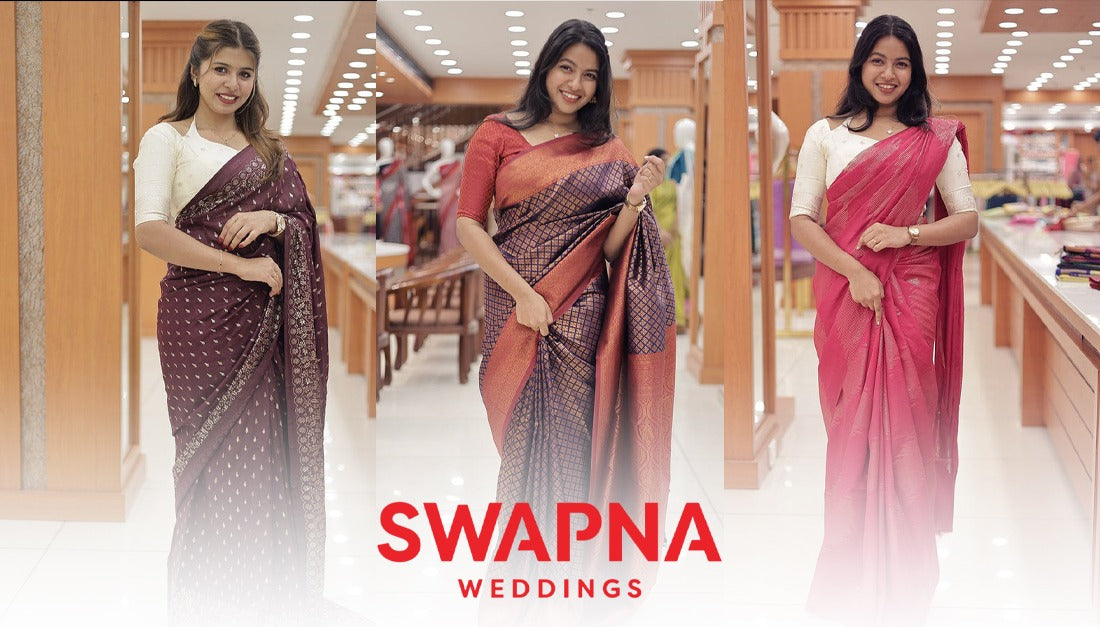
8 Different Handloom Sarees You Should Know
Share
Handloom sarees are more than garments — they are woven legacies that carry the soul of Indian craftsmanship. Every region of India has its own signature weave, telling stories of culture, tradition, and artistry through threads and motifs. Whether it’s the luxurious Banarasi, the royal Paithani, or the delicate Chanderi, each saree style is a masterpiece in its own right. If you’re someone who admires heritage fashion, our sarees collection at Swapna Weddings is the perfect place to discover these timeless treasures.
Here’s a guide to 8 different handloom sarees every saree lover should know about.
1. Banarasi Saree – The Royal Weave of Varanasi
Banarasi sarees are the epitome of luxury. Woven in fine silk with intricate zari work in gold and silver, these sarees often feature floral motifs, Mughal-inspired patterns, and jhallar borders. They are heavy, ornate, and perfect for weddings and grand occasions. Owning a Banarasi is like owning a piece of Indian royalty.
2. Kanchipuram Saree – The Pride of Tamil Nadu
Known as the “Queen of Silks,” Kanchipuram sarees are woven with pure mulberry silk. Their hallmark is the contrast borders and rich zari patterns that often depict temples, checks, and floral motifs. These sarees are considered bridal treasures in South India and can last for generations if cared for properly.
3. Chanderi Saree – Sheer Elegance from Madhya Pradesh
Lightweight, airy, and elegant — Chanderi sarees are a summer favorite. They combine silk and cotton threads with zari to create a glossy yet sheer texture. Popular motifs include peacocks, floral vines, and geometric patterns. If you love understated grace, Chanderi is the perfect choice.
4. Tussar Saree – The Golden Silk of Bihar
Also called Bhagalpuri silk, Tussar sarees are made from wild silk and have a unique golden sheen. Their slightly coarse texture adds a rustic charm, while natural dyes and tribal motifs make them eco-friendly and stylish. Tussar sarees are versatile enough for both daily wear and festive occasions.
5. Baluchari Saree – The Storytelling Weave of Bengal
Baluchari sarees are woven in West Bengal and are famous for the narrative designs on their pallus. They often depict mythological stories from the Ramayana and Mahabharata, turning each saree into a storytelling canvas. Traditionally made in rich silk with resham or gold threads, they are heritage sarees treasured by collectors.
6. Sambalpuri Saree – Odisha’s Ikat Beauty
Sambalpuri sarees are iconic for their unique Ikat technique, where the yarn is tie-dyed before weaving to form patterns. Known for motifs like conch shells, wheels, and flowers, they are vibrant, durable, and have a distinctive cultural appeal. These sarees are worn both as daily drapes and for festive occasions.
7. Bomkai Saree – Tribal Charm Meets Tradition
Originating from Odisha’s Ganjam district, Bomkai sarees combine simple tribal art with bold borders and pallus. Common motifs include fish, temples, and geometric designs. Available in both silk and cotton versions, Bomkai sarees are loved for their earthy tones and cultural symbolism.
8. Paithani Saree – The Jewel of Maharashtra
Paithani sarees, woven in rich silk and adorned with metallic threads, are celebrated for their signature peacock designs on the pallu. These sarees come in bright shades like magenta, green, and gold, reflecting royal elegance. They are considered heirloom sarees, often passed down across generations.
Why Handloom Sarees Matter
Handloom sarees aren’t just clothing — they are stories of craftsmanship, heritage, and identity. Each piece takes days or even months to weave, making them priceless in both artistry and tradition. By wearing and supporting handloom sarees, you also support local weavers and sustain centuries-old crafts.
At Swapna Weddings, our sarees collection brings together these timeless styles to help you find the perfect drape for every occasion. From festive Paithanis to elegant Chanderis, explore handloom sarees that blend tradition with modern elegance.
